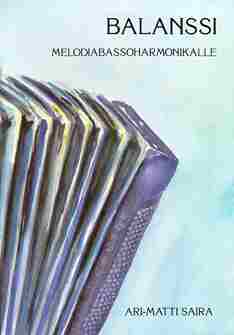
Pikku Hanuristin Lululaatikko: The Little Accordion Player's Toy Box
Balanssi: Melodiabassoharmonikalle
Kymmenen Tarinaa Harmonikalle: Ten Stories for Accordion
Taikasormi: Magic Fingers
Musikantit 1: Budding Musicians 1
Musikantit 2: Budding Musicians 2
Astor Piazzolla: Four Pieces
Publisher: AMS Production Ky
Order from: Ari-Matti
Saira
Havutie 3
FIN-31600 Jokioinen
Finland
p/fax: +358 3 4384
174
Email: amsprod@sci.fi
review date: March 1999
Review by Henry Doktorski:
I am familiar with Ari-Matti Saira from the excellent CD Coral which I reviewed in the pages of The Free-Reed Review. In addition to his accomplishments as a virtuoso accordion performer, Saira is an accomplished composer and pedagogue. The following books range in difficulty from the early beginner to the advanced student or performer. I found all the pieces (as well as the paintings and illustrations) to be attractive, musical and enjoyable. All the texts and song titles are in Finnish, although many include English translations.Pikku Hanuristin Lululaatikko (The Little Accordion Player's Toy Box) contains 41 short pieces for the beginner stradella-bass student, including Maijan Karitsa (Mary Had A Little Lamb), Tuiki Tuiki Tahtoneon (Twinkle Twinkle Little Star), Hamahakki (The Inky Dinky Spider), Pippolan Vaari (Old MacDonald), Jos Sun Lysti ON (She'll Be Comin' Round the Mountain), Jaako Kulta (Frere Jacques), and others.
Balanssi: Melodiabassoharmonikalle is a collection of 54 short one or two-page pieces suitable for the beginner to intermediate free-bass student. Many of the pieces are popular Finnish nursery rhymes (tunes which would be familiar to children) including Lontoon Silta (London Bridge), Missa On Peukalo? (Frere Jacques), Tati Maija (Long Long Ago), Old Black Joe, Kehtolaulu (the Brahms' Lullaby), Merimiesvalssi (My Bonnie Lies Over the Ocean), as well as one Yugoslavian piece -- Laiska Lassi -- in 7/8 time (which includes a duet part). For the most part, the pieces progress in difficulty beginning with two-voice pieces and going on to three-voice pieces. One piece -- Hilu Hilu -- introduces the bellows shake. Another piece -- Peppi Karilla introduces clusters in the left hand. There is quite a range of difficulty between the first and last pieces. This book is much more difficult than Pikku Hanuristin Lululaatikko.
Kymmenen Tarinaa Harmonikalle (Ten Stories for Accordion) is a collection of ten original pieces by Saira for the more advanced convertor/free-bass student. (This music is not easy!) One of my favorite pieces in this collection is Nujakka Koulumatkalla (The Boys Are Fighting Again). The piece is very clever. It is based on the universal childhood teasing theme (nyah nyah nyah nyah nyah) based on the pitches sol, mi, la, so, mi and portrays in musical language a fight between two boys, including such techniques as 1) pitch-less percussive sounds, bellows shakes on a polychord, and an eight-second-long section in graphic notation (a very advanced 20th century new music technique, actually) which is depicts chaos. The piece eventually fades out on a three-time repetition of the theme. Very clever! The text is in Finnish only.
Taikasormi (Magic Fingers) is a series of twenty-four more difficult pieces for convertor/free-bass accordion. Although Saira claims in the introduction that the pieces might be called finger exercises, they are really much more; they are good music. Some titles are: Yliveto-polkka, Gigue, Sky Line, Virtualliprinsessa, and Ignition electronique. In Two Ways To Be Happy Saira introduces the technique of playing two chord buttons simultaneously with a bass button. BeatFight is a study of changing meter (6/8 and 3/4). Copyright is written in three staves, the first for right hand, the second for the melody-bass buttons and the third for the stradella bass buttons.
The Musikantit (Budding Musicians) two-book series is devoted to chamber music for accordion and other instruments such as flute/recorder, violin, cello, clarinet, guitar, etc. although the choice of instruments is flexible. Volume I is for the beginning student and Volume II is for students who have been playing for several years. Volume I includes several folk pieces arranged by Saira and another famous Finnish accordionist Veikko Ahvenainen. I found Volume II especially interesting, as it included several pieces for accordion duo and one for accordion trio. The book consists of five pieces by Saira as well as Scott Joplin's The Entertainer, Vladmir Shainskij's Mina Soitan Harmonikka (I'm Playing Accordion), and Astor Piazzolla's Years of Solitude.
Of all Saira's books, my favorite is his accordion duet versions of Four Astor Piazzolla Pieces: Coral, Close Your Eyes and Listen, Cite Tango and Adios Nonino. All four pieces were recorded (with Saira's wife as duet partner) on the CD mentioned earlier. I highly recommend Saira's arrangements of Piazzolla; they are challenging, well-written and very interesting. I especially liked the duet arrangement of Adios Nonino, which was written by the Polish accordionist and composer Krzystztof Olczak.
The music typesetting is superb. Quite beautiful, actually, as well as easy to read.
REPLY:
Date: Mon, 22 Mar 1999 13:50:41 +0200
From: Ari-Matti Saira -- amsprod@sci.fi
Subject: Nyah nyah nyah nyah nyah guess who
Yahoo !!!
Thanks a lot for your truthful words. The one thing that can be rectified is that the 10 stories for accordion is translated, too. The translations were late and I didn't have time to print it together with the score. But now it is ready. The stories are really thought to be a part of the artistic (even for children) impression.
Another rather unimportant detail is that in the Budding Musicians 1 there is only one composition from Veikko Ahvenainen. This melody is quite popular among many young accordionists.
Yours,
Ari-Matti
| About The Free-Reed Review |
| Invitation to Contributors / Submission Guidelines |
| Back to The Free-Reed Review Contents
Page |
| Back
to The Classical Free-Reed, Inc. Home Page |